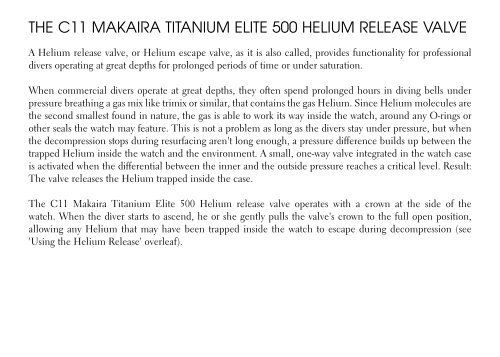C11 MAKAIRA TITANIUM ELITE 500 - Christopher Ward
C11 MAKAIRA TITANIUM ELITE 500 - Christopher Ward
C11 MAKAIRA TITANIUM ELITE 500 - Christopher Ward
Create successful ePaper yourself
Turn your PDF publications into a flip-book with our unique Google optimized e-Paper software.
The <strong>C11</strong> Makaira <strong>TITANIUM</strong> <strong>ELITE</strong> <strong>500</strong> HELIUM RELEASE VALVE<br />
A Helium release valve, or Helium escape valve, as it is also called, provides functionality for professional<br />
divers operating at great depths for prolonged periods of time or under saturation.<br />
When commercial divers operate at great depths, they often spend prolonged hours in diving bells under<br />
pressure breathing a gas mix like trimix or similar, that contains the gas Helium. Since Helium molecules are<br />
the second smallest found in nature, the gas is able to work its way inside the watch, around any O-rings or<br />
other seals the watch may feature. This is not a problem as long as the divers stay under pressure, but when<br />
the decompression stops during resurfacing aren't long enough, a pressure difference builds up between the<br />
trapped Helium inside the watch and the environment. A small, one-way valve integrated in the watch case<br />
is activated when the differential between the inner and the outside pressure reaches a critical level. Result:<br />
The valve releases the Helium trapped inside the case.<br />
The <strong>C11</strong> Makaira Titanium Elite <strong>500</strong> Helium release valve operates with a crown at the side of the<br />
watch. When the diver starts to ascend, he or she gently pulls the valve's crown to the full open position,<br />
allowing any Helium that may have been trapped inside the watch to escape during decompression (see<br />
'Using the Helium Release' overleaf).
















